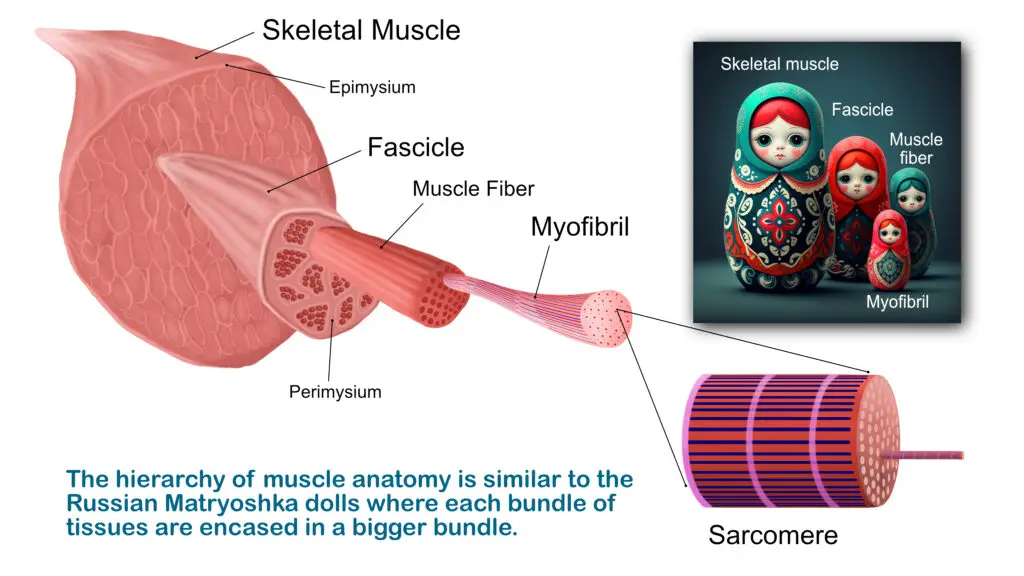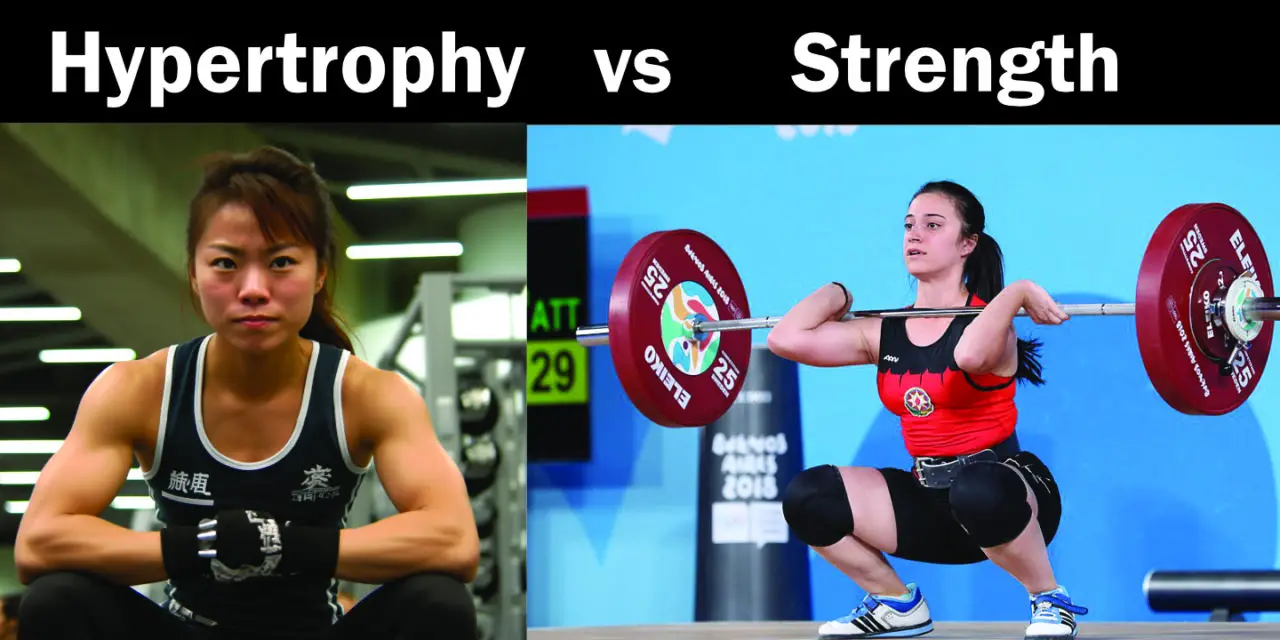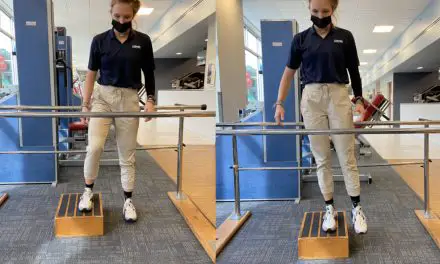Although the terms are often used interchangeably, strength and hypertrophy are different things. Strength refers to your ability to generate force. Hypertrophy simply describes an increase in muscle size. The two concepts should be thought of as distinct but related; an increase in muscle strength can lead to an increase in muscle size and vice versa.
When programming your workouts, know if your fitness goals are strength-related or hypertrophy-related. Strength goals will require lower repetitions (reps) of heavy weights while training for hypertrophy means moderate weights with more repetitions.
What is muscle hypertrophy?
Basically, hypertrophy is an increase in the size and number of myofibrils within muscle fibers. Repeating units of myofibrils are called a sarcomere, which are the contractile units of muscle fibers that contain the actin and myosin proteins necessary to generate a force.

Muscle contractions involve the nervous, skeletal, endocrine, and musclar systems to contract. The components of muscles are bundled in larger bundles like the Russian Matryoshka dolls. (Illustration by Nick Ng)
There are three main factors in muscle hypertrophy: mechanical tension, muscle damage, and metabolic stress.
Mechanical tension refers to the intensity and duration of your workout. More weight lifted over a longer period of time (called ‘time under tension’) leads to a more intense resistance training session, and thus can begin the hypertrophy process.
In an overload situation, muscle damage leads to an inflammatory response which triggers a repair process that results in muscle growth. For reasons that are poorly understood, eccentric contractions (often referred to as ‘negatives’) cause more muscle damage than concentric contractions. Creating more damage means more activation of satellite cells, which are responsible for building and repairing the new muscle fibers.
Eccentric exercise also seems to induce more production of growth factor and testosterone, both of which are necessary components of muscle building.
The metabolic stress factor is brought on by anaerobic training which decreases the body’s pH level and causes muscle fiber to break down. During anaerobic (literally: without oxygen) exercise, muscles are tasked with working in an oxygen deficit. Without oxygen, your muscles rely on anaerobic metabolism to produce energy, which leads to a buildup of lactic acid and hydrogen ions.
These byproducts are what make you feel fatigued or the famous “burn” while working out. These sensations indicate an increase in the acidity of the muscle which can damage fibers resulting in muscle breakdown.
[Further reading: Is Concentric or Eccentric Contraction Better for Bigger Muscles?]
How many reps and sets should I do for hypertrophy?
Workout intensity, or load, is arguably the most important variable in training for muscle hypertrophy. Typically, intensity is expressed as a percentage of a 1RM (one rep maximum). Training loads that are less than 65% of your 1RM, are unlikely to create meaningful hypertrophy although if you do enough reps, you may be able to create metabolic stress in the absence of overload.
Research suggests that 6 to 12 reps allows for the best combination of load and volume to produce changes in both strength and hypertrophy. Most often, hypertrophy programs use moderate-to-heavy loads, moderate-to-high reps, and several sets of each exercise to create changes in muscle size; these are high volume programs where a single workout could include 6 to 8 exercises.
There is less agreement on the appropriate number of sets for any given exercise. Generally anywhere from 2 to 6 sets are performed. Improvements in trained and untrained lifters have occurred with any number of sets.
As with the rest of the program, rest intervals are set based on intensity, goals, lifting experience, etc. Typically, rest periods of approximately 1-minute are used in hypertrophy programs because this allows the metabolic changes of anaerobic training while still giving the lifter enough time to recover strength and power between sets.
How many sets and reps should I do for strength?
Strength programming is characterized by low reps under heavy load for a moderate to high number of sets. Training with higher loads means more rest time is needed. When lifting loads that are greater than 80%, rest periods of 3 minutes or longer should be used.
Strength training relies on the same variables as hypertrophy and other types of strength training. You should have working loads that are 80% to 85% of 1RM. The most effective rep range for increasing maximal strength is 1 to 6, although, as mentioned earlier, you can build strength with hypertrophy programs as well (just not maximum strength).
You can build strength using many approaches. Among the most well-researched are the SAID principle, the FITT principle, and functional training.
The SAID principle, or specific adaptations to imposed demands, simply states that your body will adapt to the demands you place on it during training. This aligns with the principle of specificity. Both principles state that if you want to get better at any particular activity, you have to train in a way that mimics the activity.
The FITT principle is another option when designing strength training programs. FITT stands for frequency, intensity, time, and type which are key aspects of a strength program. You can manipulate these variables to create a program that meets your fitness level and works toward your goals.
Functional training has also become quite popular, thanks to the influence of CrossFit-style training. This type of workout builds strength using exercises that mimic tasks that are performed in daily activities. The goal is to improve overall physical performance through training strength, balance, stability, flexibility, and coordination. Functional training is highly adaptable as it can be tailored to fit exercisers of any age or activity level.
Benefits of muscle hypertrophy
Muscle hypertrophy comes with a variety of benefits, including better physical performance, increased bone density, reduced risk of injury, improved posture, better balance and countless others.
A few of the most common benefits are:
- Overall health: regular strength training is associated with less risk of chronic diseases such as obesity, diabetes, and cardiovascular disease. Strength training is also both preventative and a treatment option for women who have, or are at risk of developing, osteopenia or osteoporosis.
- Improved metabolism: it is easy to find support for strength training when your goal is improved body composition. More muscle tissue means a higher resting metabolic rate or metabolism. A higher metabolism means your body burns more calories doing nothing than someone with a lower metabolism. This is often a goal of people who are strength training for weight loss or to change body composition.
- Increased strength and power: generally speaking, larger muscles can generate more force which means more powerful movements. Power, the combination of strength x speed, is often overlooked when programming because it can cause injury if not performed correctly. In older adults, power can be measured as the ability to get up and down from a chair without using upper body support or walking speed, both of which are associated with living longer!
Drawbacks of hypertrophy training
Hypertrophy training has some drawbacks.
- It can be time-consuming. Hypertrophy training requires several sets of several exercises. Even with relatively short rest periods, the minutes add up.
- It can increase your risk of injury if you do not maintain proper form and technique. By the third set of your eighth exercise, fatigue may affect the intensity of your workout.
- It’s not ideal for developing athleticism. The sets and reps needed to create muscle growth do not lend to moving weight fast or creating powerful movements.
- It can create muscle imbalances if the program overemphasizes certain muscle groups over others.
What is muscular strength?
The amount of force a muscle or group of muscles can create in a single maximal effort is referred to as muscle strength. This is usually measured as the amount of weight lifted in 1RM. Sometimes it can be difficult to measure a true 1 RM because this typically requires at least one additional person to act as a spotter; in these cases, a 5, 8, or even 10 RM can be performed.
Your nervous system plays an integral role in strength training. Muscles are recruited on an ‘as needed’ basis. When you lift a light dumbbell, your nervous system only activates as many motor units as are necessary to create the force needed to move the weight.
There are two ways to increase the number of motor units that are recruited.
- Lift a heavier weight
- Lift the lighter weight until the motor units are fatigued and more units are called in for backup.
Benefits of muscular strength
Aside from the obvious aesthetic benefits, being stronger can be quite useful outside of the gym. A base level of strength helps you get up and down from the floor, navigate steps and stairs, and perform heavy activities around your home.
A few other benefits of strength training include:
- Increased bone density
- Injury prevention or rehabilitation
- Body composition
- Improved quality of life in cancer survivors
- Work-related tasks that involve climbing ladders, getting up and down from the floor, or lifting heavy objects
Drawbacks of strength training
Strength training can have some drawbacks:
- There’s a lot of ‘down time’ during strength workouts: rest breaks of more than 2 minutes can lead to hours spent at the gym waiting for your next set.
- Too much mass: it will likely be temporary but when starting a muscle-building program, you may initially gain weight as building muscle mass can be quicker than fat loss.
- Training injuries: lifting weight that is greater than 85% to 90% of your max repeatedly can lead to overuse or traumatic injuries.
Who should do hypertrophy or strength training?
Everyone should do some sort of strength training. Several studies have linked functional, strength-based tasks, such as the sit-to-stand and gait speed to mortality.
If you want to maintain the freedom to choose what activities you participate in or the ability to live independently, the best day to start your strength training program was yesterday. The second best day is today!
Whether you choose a hypertrophy program or a strength program depends on your goals. If you need to lift heavy objects at work or like to climb mountains, traditional strength programming is probably best for you. If you want to look better, feel better, and move better, hypertrophy will serve you well.
Can I get bigger muscles with strength training?
Certainly strength training can build muscle mass as a byproduct and adaptation to exercise. While hypertrophy might get you there faster, heavy lifting also causes the micro-tears in your muscles that are necessary to build size alongside your strength gains.
I’m a beginner in weight training. Should I train for hypertrophy or strength first?
The answer to this question ultimately depends on your goals. If your goal is to change body composition, develop athleticism, or build general strength and conditioning, hypertrophy programming should be followed. If you have taken up a new hobby that requires a base level of strength, want to compete in powerlifting competitions, or have a job that is mostly manual labor, you can jump right into strength training.
Regardless of what you choose, determine your starting point appropriately so that you know your loads are heavy enough to create the desired changes. A study of novice lifters who were allowed to choose their own resistance training intensity showed that they chose loads that were not heavy enough to induce changes in strength or hypertrophy.
In any percentage-based lifting you will need to know your starting point—a 1 RM, 5 RM, 10 RM, etc. Once you have this number, there are charts and calculators available all over the internet to estimate your working loads based on your program.
Feature photo (right): Sandro Halank, Wikimedia Commons, CC BY-SA 4.0

Penny Goldberg, DPT, ATC
Penny Goldberg, DPT, ATC earned her doctorate in Physical Therapy from the University of Saint Augustine and completed a credentialed sports residency at the University of Florida. She is a Board Certified Clinical Specialist in Sports Physical Therapy.
Penny holds a B.S. in Kinesiology and a M.A. in Physical Education from San Diego State University. She has served as an Athletic Trainer at USD, CSUN, and Butler University.
She has presented on Kinesiophobia and differential diagnosis in complicated cases. Penny has published on returning to sports after ACL reconstruction and fear of movement and re-injury.
Outside of the clinic, Penny enjoys traveling, good cooking with great wine, concerts, working out and playing with her dogs.






